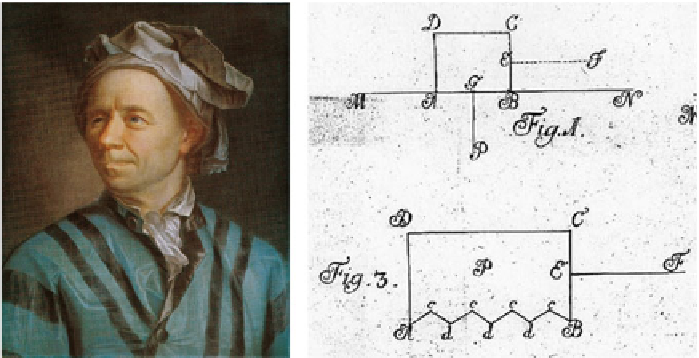Environmental Engineering Reference
In-Depth Information
Fig. 5
Left hand side
Leonhard Euler.
Right hand side
Euler's model of friction: a pair of hilly
surfaces in a saw tooth pattern, which interlock perfectly. For one body to slide over the other, an
oblique motion is required to surmount the asperities and a force F is needed. Figure taken from
Euler (
1748
)
force with a spring. He found that friction is proportional to the normal force and
independent on the area of contact. He called the proportional factor friction constant;
erroneously, he believed in the existence of a universal friction coefficient. While
Leonardo tested static friction, Amontons dealt with kinetic friction.
It was found by Leonhard Euler by 1748 (Fig.
5
) that one has to distinguish
between static and kinetic friction (Euler
1748
). He studied theoretically the mecha-
nism of the sliding motion of a block on an inclined plane. He adopted the model of
rigid interlocking asperities as the cause of frictional resistance. He concluded that
static friction is always larger than kinetic friction. With these assumptions he was
able to describe analytically the motion of a block on an inclined plane.
In 1773, the third classic friction law came into being with Charles-Agustin
Coulomb's research, which posited the theory that friction is independent of sliding
speeds. Coulomb (Fig.
6
) did the first attempts to develop some theories pertaining
to design of foundations and other constructions. Coulomb formulated the theory of
Earth pressure (Coulomb
1773
). In this theory, Coulomb also introduced the concepts
of frictional resistance and cohesive resistance for solid bodies, which he assumed
to be applicable
to granular bodies
, including soils, which was intuitively used by
Leonardo da Vinci three centuries before.
The macroscopic law of Leonardo appears to be a true paradox. Intuitively one
would expect the friction force to be proportional to the area of contact. The paradox
was resolved by Bowden and Tabor (
1950
), who gave a physical explanation for
the laws of friction. They determined that the true area of contact is a very small
percentage of the apparent contact area. The true contact area is formed by the
asperities. As the normal force increases, more asperities come into contact and
the average area of each asperity contact grows. The frictional force was shown to

Search WWH ::

Custom Search